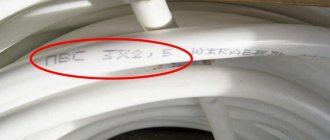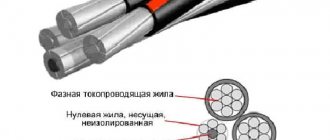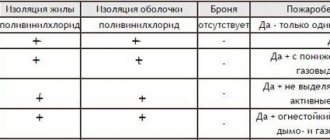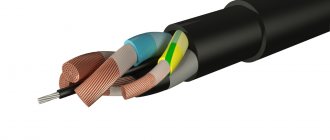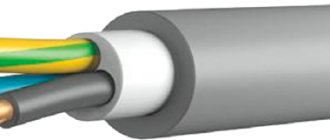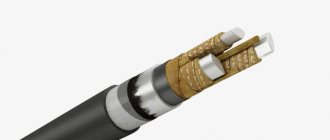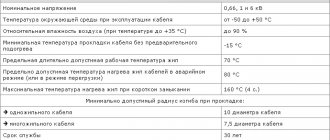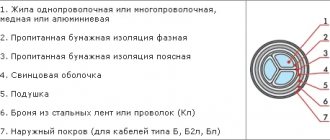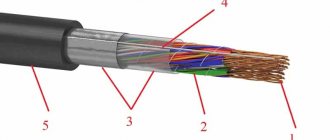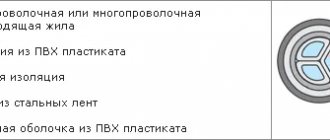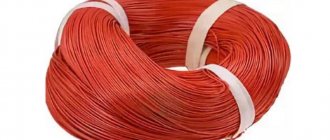Decoding and application
Most specialists working with electricity know what PVC wire means. The decoding of this abbreviation is interpreted as follows:
- P - belonging to the category of wires.
- B - the presence of an outer vinyl shell (in this case, polyvinyl chloride).
- C - belonging to the power class.
In the marking of conductors of this type, additional letter and number combinations are used, reflecting the design features and functional properties of individual products. The most common designations are:
- a - the presence of aluminum in the composition;
- b — presence of armor;
- d - lack of insulation;
- l - conductor made of tinned copper;
- t - increased resistance to humidity, called the “tropical” version.
- PS - shell made of polyethylene with polyvinyl chloride;
- pv - a shell made of rubber mass and PVC.
The marking is always applied to the outer surface of the conductor. In addition to letters, it may contain the numbers 2, 3, 4 or 5. They indicate how many cores were used in its production. After the number of cores, an x sign is placed and then another number follows (this can be 0.75, 1.00, 1.50, 2.50), indicating the cross-section of the wire.
The category of electrical conductors of the PVA type has found wide application in various fields. Most often they are used to:
- connecting household electrical appliances (such as refrigerators, microwaves, irons, etc.);
- connection of electrical network elements designed for a rated voltage of 380 V;
- installation of wiring in residential and domestic premises;
- connection of small agricultural equipment.
Despite the great possibilities of using PVA cable, it has some disadvantages. The main one is the inconvenience of laying hidden wiring. The round shape prevents it from being tightly laid under the plaster.
Application
Actually, the scope of application is indicated in the name - “connecting wire”. Its main purpose is to connect to the network various stationary or mobile (portable) electrical equipment powered by a voltage of no more than 380 V.
Given the flexibility of this type of wire, it is excellent as a household extension cord.
Household extension cord
But it must be taken into account that PVA insulation is not designed for outdoor use. It breaks down under ultraviolet radiation and is susceptible to moisture.
Now let's move on to the question of using PVA when installing electrical wiring. This is not what you can do. To immediately exclude the argument, which indicates the absence of a direct prohibition in the PUE. Let us provide excerpts to put an end to this dispute.
Excerpts from SP and PUE
This alone is enough to cause problems when obtaining insurance in the event of a fire in an apartment or house.
Please note that according to the above excerpts, installation with PVS ng wire is allowed. But there are the following arguments against this option:
- Pay attention to the service life, even for stationary installations it is 12 years; further, the insulation’s preservation of its properties is not guaranteed. Wiring laid with VVG cable will last almost three times longer.
- PVS ng is more expensive than VVG.
The above arguments are quite sufficient to demonstrate the absurdity of such a decision.
Marking
The general insulation and shell of phase conductors are marked in accordance with the PVA color marking standard:
- The overall insulating sheath is always painted white. Sometimes there are two diametrically located stripes of a different color.
- Black, red, yellow, gray and brown colors are used to mark conductive wires.
- If there is a “zero” phase, it is indicated in blue.
- Green or yellow-green color is reserved for the ground wire, but it is rarely found in PVA.
Marking of PVS wires is carried out in accordance with the requirements of GOST 7399-97. Decoding the notation is very simple:
- the presence of the letter “l” indicates that the phase wires are made of tinned copper (PVC);
- the capital letter “T” indicates the climatic design of the cable;
- “A” in the marking means that the cable uses aluminum conductors;
- “B” - armored wire;
- PS - the cable insulating sheath is made of a mixture of self-extinguishing polyethylene and polyvinyl chloride;
- G – cable without insulation;
- ШВ – outer insulating shell made of flat polyvinyl chloride;
- PV - the outer insulating shell is made of a mixture of PVC and vulcanized rubber;
- the first number following the letter designations indicates the number of cores inside the cable;
- the number following it is the cross-sectional area of the conductive conductors.
In order to find out the exact physical characteristics of the PVA cable, you should refer to the following table:
| The wire | Number of cores/sectional area of each (mm2) | Number of wires in phase conductors/diameter | Weight of 1km cable (kg) | Outer diameter (mm) | Max Diameter(mm) |
| PVS | 2×0,75 | 24×0,2 | 55,8 | 6,4 | 7,2 |
| 2×1,00 | 32×0,2 | 63,7 | 6,7 | 7,5 | |
| 2×1,50 | 30×0,25 | 85,15 | 7,6 | 8,6 | |
| 2×2,50 | 50×0,25 | 133 | 9,4 | 10,6 | |
| 3×0,75 | 24×0,2 | 66,1 | 6,8 | 7,6 | |
| 3×1,00 | 32×0,2 | 76,5 | 7,1 | 8 | |
| 3×1,50 | 30×0,25 | 107 | 8,3 | 9,4 | |
| 3×2,50 | 50×0,25 | 166,7 | 10,2 | 11,4 | |
| 4×0,75 | 24×0,2 | 79,8 | 7,4 | 8,3 | |
| 4×1,00 | 32×0,2 | 96,5 | 7,9 | 9 | |
| 4×1,50 | 30×0,25 | 134,5 | 9,2 | 10,5 | |
| 4×2,50 | 50×0,25 | 203,8 | 11,1 | 12,5 | |
| 5×0,75 | 24×0,2 | 102 | 8,3 | 9,3 | |
| 5×1,00 | 32×0,2 | 118,4 | 8,7 | 9,8 | |
| 5×1,50 | 30×0,25 | 170,6 | 10,3 | 11,6 | |
| 5×2,50 | 50×0,25 | 257,6 | 12,4 | 13,9 |
This is interesting: How to check the voltage in an outlet with a multimeter and a screwdriver (video)
Accepted colors
The above GOST does not impose any special requirements for the coloring of external insulation; 10 color options are allowed: white, black, gray, etc.
As for the color of the core insulation, it must correspond to the table below.
The color chart for insulation is live depending on their purpose and quantity:
| Number of cores | Accepted color standard | |
| there is a grounding conductor | No grounding conductor | |
| 2 | brown, blue | |
| 3 | yellow-green, brown, blue | black, brown and blue |
| 4 | yellow-green, black, brown, blue | blue, black, brown, black or brown |
| 5 | yellow-green, blue, black, brown and black or brown | blue, black, brown, black or brown, black or brown |
The purpose depending on the color of the insulation is shown in Figure 3.
Figure 3. Colors according to GOST for neutral, protective and phase conductors
Please note that sometimes the insulation of the phase conductor is also white, which is acceptable according to the international standard.
Having finished with the design features and color designation, let's move on to the description of the main parameters.
Advantages and disadvantages
The positive qualities of PVA wire include:
- copper is a light metal, so the entire structure as a whole is characterized by minimal weight;
- possibility of use in electrical networks with a voltage of 220/380 V;
- increased flexibility, thanks to which the product can be laid on structures with sharp turns requiring a steep bend radius.
The disadvantages of PVA are associated with limited installation capabilities (hidden wiring or underground installation are not allowed). In general, due to the round shape of the cable, even with a strong desire to organize hidden wiring, you will encounter great inconvenience. Finally, the cost of PVA is higher in comparison with its analogues.
Description of properties and decoding of PVA
PVA wires are used not only for connecting household appliances to a voltage of 220 V. Some varieties can be used to transmit voltages up to 660 V. The service life of the wire can also range from 2 to 10 years. It all depends on the operating conditions and the quality of the insulation material. The abbreviation for the name of the wire PVS means:
- “P” is a conductor.
- “B” - polyvinyl chloride insulation.
- “C” - “network”.
This abbreviation also indicates the method of packaging conductive wires into a single cylindrical PVC bag.
One of the purposes of PVA wire is the ability to be used outdoors. Therefore, the permissible operating temperature range for it is from -30° below zero to +45° above zero. The permissible heating temperature of the PVA wire is +80°, after which its shell begins to melt and collapse, which can lead to a short circuit. The PVS cable is considered a flexible conductor, but it has a bending strength of up to 50,000 in one section.
This is interesting: How to turn off the light in an apartment through a panel: this is useful to know
Basic properties of wire
Next, let's look at the main properties of the PVA cable; after all, for the most part, its installation location and choice depend on them.
According to GOST, the service life of the wire is 6 years. However, as a rule, the service life is significantly longer if the product is not exposed to negative external influences. According to the instructions, the cable sheath is not subject to combustion, however, this does not exclude exposure to high temperatures. Based on the previous point, it is worth saying that the most favorable temperature range for PVA wire is considered to be the border between – 25 and + 40 degrees. At the same time, you should not install the cable at temperatures less than minus 20 degrees and more than plus 70. According to GOST 22483-77, the cores of the PVS cable correspond to class 5
This is worth paying attention to when choosing a section! For example, for a wire whose core has a nominal cross-section of 1.0 mm2, a single wire should be no more than 0.26 mm2.
According to GOST 7399-97, insulation depends on the cross-section of the cores and varies within 0.6-0.8 mm. In this case, the thickness of the shell can vary within 0.8-1.2 millimeters, providing a resistance not lower than that proposed in GOST.
Important! Pay attention to paragraph 4.1.1.6 of GOST 7399-97, according to which there should be no visible dents or bulges on the surface of the PVA cable. At the same time, the wire sheath is made in such a way that there are no voids between the veins. To achieve this, it is permissible to use additional materials
With any approach, separation of the cores from the sheath should occur without difficulty
To achieve this, it is permissible to use additional materials. With any approach, separation of the cores from the sheath should occur without difficulty.
PVS
PVA cable is a flexible copper wire. Its flexibility is very good, so you can install any electrical systems without fear of breakage. According to the standard, the conductors in the wire are assigned the fifth class of flexibility, which is one of the best results, especially considering the excellent resistance to various mechanical loads and deformation. Plastic insulation reliably protects the copper base from corrosion and is resistant to the appearance of various fungi.
The name PVS stands for:
- P - belongs to electrical products that distribute electrical energy.
- B - for cable insulation, vinyl is used both externally and for insulating a separate core.
- C - designed for creating electrical networks.
If you look closely at the insulation, you will notice that it has an outer and an inner layer. The material used to create the insulation layers is polyvinyl chloride plastic. Thanks to it, the wire is not subject to combustion and can withstand elevated temperatures.
The cores are insulated from each other and twisted in a spiral. In accordance with the international standard, each cable core is painted in its own color so that the neutral and phase cores can be identified. If there is a zero phase, then it is painted blue, green or yellow-green corresponds to the ground wire, and the remaining colors mark the current-carrying conductors.
Cable Specifications
The technical characteristics of the PVS wire are determined by the state standard. But GOST only indicates a range of values, and the actual parameters may vary for different manufacturers. Therefore, to obtain accurate data for a specific cable, you need to look for the manufacturer’s documentation.
Description of technical features:
- The temperature range at which the wire must be operated is from -25 to 40 degrees Celsius. At the same time, the cable can withstand temperature increases of up to 70 degrees and even a short-term jump to 90.
- Suitable for use in rooms with high relative humidity and resistant to fire.
- The line voltage of the network should not exceed 660 volts.
- Resistance to deformation when bent in both directions is 30 thousand times.
- The number of cores can vary from 2 to 7.
- Manufacturers provide a 2-year warranty from the moment the wire is put into operation. In this case, the service life is at least 6 years. When used in stationary electrical devices, the service life can reach 10 years.
There are PVA made of aluminum. They are used in urban wiring and industry. Main differences from copper cables:
- When an electric current passes, aluminum heats up less than copper. This provides greater stability and power of the conducted flow of electricity.
- Wires made of aluminum that have undergone oxide treatment can be used in high-power facilities. Oxide treatment increases service life.
- Aluminum weighs less than copper. This property is useful for constructing high-voltage transmission lines and allows you to reduce the number of required supports.
- The cost of a cable made of aluminum is less than that of copper, and at the same time it has a service life no less and is not inferior in flexibility.
Application area
The PVS wire is used in the following:
- connecting power tools;
- various extension cords, carriers;
- lighting of residential buildings, outdoor lighting.
To protect against rust, some cables are coated with tar, for example, VVG, APPVS, KSVP.
The use of PVA wire for a hidden apartment wiring system is not recommended. Its purpose is only to connect and for the same price you can purchase a more suitable analogue. But there is no prohibition on this in the state standard, so you can use the cable for fixed wiring. When installing, remember to use clamps or crimp the cable.
PVS wire - technical characteristics, scope of application, operating conditions
PVS wire. To understand, let's decipher the abbreviation: “P” means “wire”; “B” means “polyvinyl chloride insulation”; "C" means "connecting".
As you can see, PVA wire is a connecting wire in PVC insulation.
What is the market situation? Today there are a lot of options for a wide variety of conductors. Including among the PVS wires. They can vary both in the number of conductors, cross-section and weight, and in the manufacturing company.
In order to clearly understand for what work which wire is intended, you need to understand the technical characteristics of the PVS wire and its scope of application.
Design
Let's try to highlight the basic design features of the PVS cable. Among them:
- the number of current-carrying cores is from two to five;
- outer diameter of the cores - it can be in the range from 5.7 to 13.9 millimeters;
- cross-sectional area (in the range from 0.5 to 25 square millimeters, where the first and last standard sizes are used quite rarely);
- core insulation material and outer protective sheath of the wire – polyvinyl chloride;
- stranded flexible conductors are made of copper (flexibility class - fifth, according to GOST);
- color marking of wires – complies with standards;
- the mass of the PVS wire ranges from 54 to 256 kilograms per kilometer.
To make it easier to systematize information about the design of the PVA wire “in your head,” we suggest that you familiarize yourself with the following plate:
Under what conditions is the wire used?
The main indicators of the operation of PVS wires include:
- Operating (or rated) voltage is up to a maximum of 600 Watts.
- Electric current frequency – 50 Hz.
- The temperature at which the wire is allowed to operate is in the range from - 25 to + 40 degrees Celsius (while electrical installation itself is possible at temperatures from - 15 degrees Celsius and above).
- The maximum permissible core temperature is up to + 70 degrees Celsius.
- The operational period of the PVS wire is up to ten years (the warranty extends for two years, however, if the conductor is planned to be used with frequent bends, its service life will be reduced by almost half).
- The operating life of the wire is 30 thousand cycles (or 60 thousand movements - bends - at rated voltage).
Let us remember that if the letter “T” (PVS-T) is added to the abbreviation, it means the wire is capable of working in conditions of increased dampness (the tropical version of PVS-T makes it invulnerable to mold).
Where is PVS wire used?
If we talk about the scope of use of the PVS cable, it’s worth going into a little detail. Did you know that this wire is used to connect most household electrical appliances? At the same time, purely visually, the PVS wire may strongly resemble the VVGng cable and other similar cable models.
In everyday life, PVS cable is often used for repairing electrical equipment - for example, when replacing an old cord with a new one. Using a wire, lighting fixtures (for example, a chandelier or sconce) can be connected to the power line.
Also, PVS wire is an excellent wire option for making an extension cord (the main thing, if you have plans to make an extension cord yourself, do not forget to calculate the required cross-section of the conductor in terms of current and power to select the optimal core diameter).
We strongly advise you not to use it when carrying out stationary residential wiring. This is because in such a case the wire will show all its shortcomings. Among the main ones:
- this product is not at all intended for use as electrical wiring (this is due to its low service life and low fire safety properties);
- the PVS wire is intended exclusively for a simple connection and not in any way for conducting an electrical line (which is primarily evidenced by the decoding of the marking itself);
- for the same money that you will spend on purchasing a PVS, you can buy a high-quality analogue that is more preferable for wiring.
What is important: neither GOST nor PUE say anything at all about the inadmissibility of using a wire as a hidden wiring, connecting sockets and switches, as well as grounding. We can conclude that you still have the right to try wiring using PVA.
If you are determined to do this, take care in advance of the correct selection of the cross-section of the cores, that the line does not pass through on the street, and that the air temperature corresponds to the permissible operating temperature of the wire. It is worth remembering that the cores of the PVA wire are multi-wire and it is necessary to carry out tinning before connecting.
Reliable manufacturers
When comparing different companies producing wire, it is difficult to single out one manufacturer. There are also a huge number of counterfeit products on the market at the moment. Due to these and many other aspects, we cannot recommend a specific company to you.
What we can advise is to double-check the cross-sectional area when choosing a wire, because often the code indicated on the insulating layer does not correspond to reality. And an incorrectly selected wire is always a risk. The risk that the power line in your home will fail during another overload.
Characteristics
PVS wires have the following technical characteristics:
- Depending on the cross-section of the phase elements, the product can withstand current up to 2 kW;
- When stretched, rupture occurs after the length has increased by one and a half times;
- The optimal operating temperature ranges from plus 40˚C to minus 25˚C;
- Frost-resistant grades of PVA are marked with a special symbol “Y”. It indicates a lower temperature threshold of up to - 40 ˚C;
- The warranty period is usually 2 years;
- When laid alone, the shell of the product does not support combustion. In case of fire during prolonged contact with an open flame, it has the property of self-extinguishing;
- PVA-T has a coating that has a number of special properties that increase service life in hot and humid climates;
- Can be used at high air humidity (up to 98%);
- The safe bend radius is at least 4 cm;
- The resource of uninterrupted operation when used as a temporary wiring or carrying element is 5000 hours. When used as stationary and permanent wiring - 12,000 hours.
A PVS cable from different manufacturers may have different technical characteristics, even if the markings are the same. Differences may relate to parameters such as:
- Thickness of the insulating layer;
- Conductor cross-section;
- The number of copper wires in the strand.
An exact description of the properties of a particular PVA can be found in the supplier's documentation.
Watch this video on YouTube
Marking
For existing brands of PVC, the decoding of designations has the following standards (GOST 7399-97):
- Tinned copper as phase wires - PVSL;
- Antiseptic additives in the insulation material - PVST;
- The flat section of the outer insulating layer is “ShV”;
- Reinforced outer protective shell - “B”;
- The insulation material has increased combustion resistance - “PS”.
In addition to the letter code, the PVC cable marking contains numbers, which are deciphered in the following order:
- The number of conductors is indicated by the first digit.
- After the “x” icon follows the cross-sectional area of 1 core in millimeters:
| Two-core | Three-core | Four-core | Five-core |
| 2x2.5 | 3x2.5 | 4x2.5 | 5x2.5 |
| 2x1.5 | 3x1.5 | 4x1.5 | 5x1.5 |
| 2x1 | 3x1 | 4x1 | 5x1 |
| 2x0.75 | 3x0.75 | 4x0.75 | 5,0,75 |
The same numbers indicate the weight of 1 km of the product:
| 0.75 mm² | 0.1 mm² | 1.5 mm² | 2.5 mm² | |
| Two-core | 55.8 kg | 66.1 kg | 79.8 kg | 102 kg |
| Three-core | 63.7 kg | 76.5 kg | 96.5 kg | 118.4 kg |
| Four-core | 85.15 kg | 107 kg | 134.5 kg | 170.6 kg |
| Five-core | 133 kg | 166.7 kg | 203.8 kg | 257.6 kg |
additional characteristics
PVS is a designation for a standard product. Special parameters are marked with additions to the labeling:
- ng – non-flammable shell material;
- FR – increased resistance to open flame;
- LS – normalized low smoke emission during combustion;
- P – flat modification of the structure.
For your information. The “non-flammability” of materials is ensured by special flame retardant components of the polymer composition.
The additional symbol in the name PVSN emphasizes the unsuitability of the structure for reinforcement with non-removable type reinforcement. This means that such products cannot be connected to a power plug with a molded connection. The technical parameters of the pvsn wire correspond to the standard values discussed above.
Description
The design of this wiring is no different from the similar one. The conductors, made of copper, are protected by a polymer coating. PVA marking means the following:
- P – wire. It is indicated that the product belongs to the electrical wiring class and is intended to transmit electricity.
- B – vinyl. The insulating layer is made from this material. Moreover, it is used to protect each core and produce a common shell.
- C – connecting. Functional purpose.
The main characteristic of PVA is the diameter of the cores and their number. They are made of copper and can be solid or made up of several individual wires twisted around a base. To mark each core, it is customary to use standard colors:
- White - denotes the outer protective sheath, inside which there are insulated wires.
- Black, brown, red - this is how the phase conductor is usually marked.
- Blue – zero.
In some cases, green indicates a ground wire. When choosing, you should pay attention to the product labeling. It is carried out in accordance with GOST 7399-97. Let's look at the example of a typical designation - PVA 2×1.5. This means that the cable includes 2 insulated cores with a diameter of 1.5 mm each. In some cases, it is necessary to know the number of wire elements and their cross-section. Then you should use the table data. It also indicates the specific gravity of the cable and the possible outer diameter.
The technical characteristics of the PVS wire make it possible to use it in almost all areas where it is necessary to connect from a source of electricity to a consumer point.
Characteristics
When choosing a cable, you should pay attention to the number of conductors, their diameter and performance characteristics. The latter are an important point, since due to the properties of the vinyl sheath, it is possible to install the cable in damp rooms with the possibility of water getting on its surface
In this case, it is necessary to follow the rules for connecting individual sections of wiring. The joints are carefully isolated. It is best to use special heat-shrinkable tubes for this.
Technical characteristics of the PVS cable, common to all types of products:
- The maximum voltage is 450 V.
- Thermal stability belongs to class Y. It is characterized by limiting the heating temperature to +70°C.
- Standard fire resistance class. The insulation material is not flammable and does not support combustion when exposed to an external flame.
- The product has high mechanical strength and is characterized by good resistance to bending damage.
- Depending on the type of operation, the service life can range from 6 (mobile state) to 10 (stationary) years.
To all this I would like to add the affordable cost of PVS wire. Due to the above characteristics, the scope of application of this type of wiring is quite extensive.
Application
Most often, the cable is used as a current-carrying line to connect energy to device devices. It can be installed to create wiring in a house or apartment. But before this, the nominal and maximum network load indicators must be calculated. In accordance with the data obtained, a product with an optimal cross-section is selected. In household appliances, PVA is used to connect electrical appliances to sockets.
Generally speaking, PVA wire is one of the most common types of electrical wiring for household and industrial use. The choice of core cross-section should be based on the calculated data of the entire project or the parameters of the connected device. Only in this way will PVA be able to fulfill its functions as a conductor of electricity.
VVG cable compared to PVS
VVG cable has good qualities and a relatively low price. Its purpose is alternating current networks: voltage from 660 to 3000 V, operating voltage from 1 kW to 3.5 kW. It can have from 2 to 6 conductors, with a core cross-section of 1.5 - 250 mm2.
They have the same copper conductors and polyvinyl chloride insulation. The main difference is in the flexibility class. PVA is elastic and belongs to class 5. The VVG cable has class 1 or 2. The diameter of the wire and their number in the core depend on this. For example, a VVG cable of class 1 flexibility with a cross-section of 2.5 mm2 may have only one wire 1.78 mm in diameter. The same PVA will consist of 50 wires with a diameter of 0.25 mm.
The product differs in profile type. The veins of small diameter are round, and the large ones are sectorial. Another difference is the thickness of the insulating material and shell. For the cable, the thickness of the inner layer is 0.8 mm, the outer layer is 1.5. For PVA, respectively – 0.8 and 1.1 mm.
There are different modifications of the VVG cable. Hidden wiring in the room is possible. It is used for outdoor installation. An overhead or underground electrical cable requires additional protection with a corrugated sleeve.
Performance characteristics and scope of application of PVS wire
PVA wire has become widely used due to its performance characteristics. Indeed, unlike wires of other brands, it has a number of significant advantages. And its main disadvantage may be the price, which is much higher in comparison with other similar aluminum products.
- One of the main features of PVS wire is its flexibility. Thanks to the structure of the cores, which are made of a large number of small wires, bending the wire at any angle does not cause any problems.
- The presence of a protective sheath, which is installed by GOST PVA wires, makes the conductors less susceptible to mechanical damage.
- Different types of colors for the wire cores make it easier to install. In addition, this increases the ease of repair. After all, even if there is damage in the center of the wire, color marking (see Marking wires and cables according to the rules) will allow you to easily determine the purpose of the damaged core.
- As for the scope of application, the characteristics of PVA wire allow it to be used in a wide range. So it is often used to connect power tools.
- The flexible structure and the presence of an additional shell allow it to be used to create carriers and extension cords.
- Since, according to the PUE, only copper wires have been allowed to be used for lighting residential buildings since 2001, PVS and PVSP wires have found wide application in this area.
- Good characteristics for outdoor use have ensured that the wire is widely used in outdoor electrical networks and gardening.
- The ease of DIY installation has ensured that the wire is widely used in electronics and electrical devices.
Difference between wire and cable
Due to the similar areas of application of these electrical products and similar cables, a reasonable question may arise - is it still a cable and a wire, and what is their fundamental difference?
Read here! Replacing wiring - norms and requirements for repair work and proper installation of electrical wiring
From a technical point of view, PVA is a wire. This can be understood from the markings (which will be described below). PVS does not have the technical parameters of the cable to have this status. A cable is a rather complex system consisting of a certain number of conductors, each of which has its own insulation.
The insulation of conductors, in turn, is supplemented by various protective and intermediate layers and shells. The structure of the wire is much simpler - from one to several cores in individual insulation, a single shell that provides protection from external influences.
Another difference between PVS wire and cables is the greater flexibility and lower weight of the former. For this reason, they are convenient for indoor use, but are not used for transmitting electricity over long distances.
Several types of PVS wire
PVA wire is divided into several types:
- interior;
- outer;
- copper;
- aluminum.
Comparative characteristics of the types of wires are presented in the table.
| View | Peculiarities | Advantages |
| Outer | The presence of three conductors: phase, neutral, ground | Can be used to supply voltage from a transformer to a distribution board |
| Interior | The presence of three conductors: phase, neutral, ground | Designed for indoor use |
| Copper | Copper conductors | Low resistance, ductile, high strength |
| Aluminum | Aluminum conductors | Low cost, extended service life |
It is not possible to present the cost of all types of wires in the table, since the price depends on several factors:
- wire sections;
- execution option;
- bay footage;
- manufacturer;
- region of residence;
- remoteness of the region from the manufacturer.
KSPV
The KSPV cable is a signal wire used for fixed internal installation when connecting alarm systems, communications and messages in networks.
Its name is deciphered as follows:
- K - cable.
- SP - transmission systems.
- B - in a vinyl shell.
KSPV insulation consists of polyethylene and is hidden behind a polyvinyl chloride shell. The most common type is without insulation.
Specifications
The KSPVG cable has the following technical characteristics:
- Contains at least two cores. They can be made of aluminum and copper. There is no insulation.
- The service life of the product is at least 15 years when used in temperatures ranging from -40 to 70 degrees Celsius.
Explanation of cable markings
The names of cables may contain various letters that determine their additional characteristics:
- A - the core of the aluminum core.
- B - reservation.
- BPI - wire cores are equipped with a paper layer impregnated with a non-flammable substance.
- B - insulation consists of paper.
- G - no insulation.
- KG - increased flexibility.
- NG - not subject to combustion.
- P - insulation is based on polyvinyl chloride.
- PS - insulation based on polyvinyl chloride using polyethylene.
- PV - the shell consists of polyvinyl chloride and vulcanized rubber.
- R - rubber insulation.
- C - lead insulation.
- F - power cord.
- ShV - flat shell made of polyvinyl chloride.
Application area
Cables of the KSPV brand are used for installation of alarm systems and telecommunications with operating voltages up to 250 V AC. For internal fixed installation of communication systems. The price of KSPV is quite reasonable, so it is a good budget option for direct installation of network connections.
Description of non-flammable analogue
Among the analogues of this brand, we can highlight the PVSng-LS wire. Its scope of application in a network of various devices is varied. It is also widely in demand for connecting electrical appliances that require increased fire safety to the network. The decoding of the last four letters of the abbreviation PVSng-LS means:
- ng - non-flammable cable,
- LS – in case of fire, low smoke and gas emissions.
Structurally, PVSng-LS wires belong to class 5 according to GOST 22483-77. Provided that the number of cores is 7, digital markings are applied to their insulation. All insulated conductors are twisted.
Wires, where the number of cores is 5, are twisted into a core.
Construction, appearance
The design of the PVA wire is clearly visible in the photo. Twisting the conductor from thin copper strands gives flexibility. The number and diameter of veins determine the total cross-section. Copper cores can be tinned or have a galvanic coating to prevent oxidation.
The twisted core is covered with an elastic layer of multi-colored vinyl insulation. Conducting insulated conductors (1-10 pieces) are twisted and filled with soft PVC outer shell, forming a monolith without voids. The shape is round in cross section. Models that increase tensile strength use a central dielectric rod.
The arrangement of conductors in one row forms a flat product of the PVSP brand.
The shell must be intact, without dents, bulges, or cracks. Separating the cores from the sheath is easy.
The letters indicate the brand, the numbers indicate the number of conductors (2-7), the cross section is written through X (0.5-10.0 mm²).
The designation PVA 3x4 shows Vinyl Insulated Connecting Wire, 3 conductors have a cross-section of 4.0 mm² each.
All about PVS wire in GOST 7399-97
Domestic manufacturers of PVS wire working for the Russian and CIS markets strive to comply with the requirements of GOST 7399-97, since it has interstate status. In addition, this facilitates export operations to non-CIS countries, since the content of the document is synchronized with the relevant parts of the international standards IEC 60227-1-93 (97) and IEC 60245-1-94 (97).
Sections of GOST 7399-97 contain all the most important information about the range, mechanical and electrical characteristics of PVA wire, as well as safety requirements, a list of tests, etc.
Marking example:
PVA 2x0.75+1x0.75 GOST 7399-97
The wire of the PVA brand is designated here; it has two main conductors with a cross-section of 0.75 mm2 and one grounding conductor with a cross-section of 0.75 mm2.
Specifications and description
- Application for operation in electrical networks with operating voltages up to 660 V.
- AC frequency 50 Hz.
- The resistance per kilometer of wire is 270 Ohms.
- The wire can be used in the temperature range from -25 to +40 degrees.
- Short heating of the cores is allowed up to +70 degrees.
- The insulation is double made of polyvinyl chloride; this material is self-extinguishing.
- Service life is 6-10 years.
The PVS cable is manufactured in accordance with GOST 7399-97. It consists of multi-core wires, of which there can be from two to seven in a cable. Each core has polyvinyl chloride insulation and the wires are marked in different colors. The neutral conductor is blue or blue, and the grounding conductor is marked yellow-green. The top is covered with another polyvinyl chloride shell, which can also be of different colors.
If the letter “P” is not indicated in the marking, then the wire has a round shape. It is thanks to this shape that it looks nice on household appliances. This shape allows it not to twist or bend when used as an extension cord. There are options on the market with a flat shape, but they are much less common.
The cross-section of the cores has a fairly wide range: from 0.5 to 16 square millimeters, which technically allows the cable to be used for industrial purposes, including as a power wire.
Due to its low service life (up to ten years in total), this wire is not recommended for use in the manufacture of stationary electrical networks. In this case, it is better to choose an electrical cable marked VVG. This wire has a service life of 30, not 10 years, like PVS.
Also, the characteristics of the PVA cable insulation in relation to temperature conditions (in some regions) will not allow this wire to be used as a street wire. For example, VVG wire operates at temperatures from -50 to +50 degrees. Although there is a PVS wire marked “U”, which indicates the outdoor use of this cable, the range only extends to -40 degrees.
Overall this is a good wire. If it is used for its intended purpose and the maximum characteristics of this electrical wire are not exceeded, then it is able to cope with the tasks assigned to it, and its service life may be longer than stated in the technical specifications.
Classification and price
According to GOST, PVA is classified according to the following points:
- number of cores – from 2 to 5;
- the cross-sectional diameter of each core is from 0.75 to 2.5 square meters. mm.
PVA 3x4 PVA 3x1.5 PVA 2x2.5 PVA 5x2.5 PVA 3x2.5
Depending on the number of cores, cross-sectional area, as well as the pricing policy of the trading company, the price per linear meter of products ranges from 8 to 50 rubles.
Types of insulation
Insulation types:
- Polyvinyl chloride (PVA). PVA is a relatively inexpensive and easy-to-use material that can be used in a variety of applications. The maximum temperature range is from minus 55 to 105 degrees Celsius. The polymer is resistant to flame, moisture and abrasion. It also resists gasoline, ozone, acids and solvents. It can also be used for medicinal and food purposes as it is odorless, tasteless and non-toxic. PVA shells can be used in heavy and thin-walled structures. PVA should not be used when flexibility and extended flex life are required at low temperatures. It also exhibits below-average flexibility when used in devices with retractable cords. PVA shells exhibit high attenuation and capacitance loss, meaning that power is lost when used in an electrical system.
- Semi-rigid PVC (SR-PVC). Mainly used as primary insulation and very resistant to abrasion. (For thicknesses 30-16, 10mm wall is UL 1061 style, 80 degrees Celsius, 300 volts.) Semi-rigid PVA is fire resistant and also resistant to heat, water, acids and alkalis.
- Plenum Polyvinyl Chloride (Plenum PVC). Plenum PVC is suitable for use in areas behind drop ceilings or raised floors that are left open to allow air circulation. Standard PVA is considered a non-film insulation option because it does not have the qualities required for safe indoor use. To achieve rated density, insulation must meet more stringent fire codes.
- Polyethylene (PE). This connection is used most often in coaxial and low capacitance cables due to its typical electrical properties. Many times it is used in these applications because it is affordable and can be foamed to reduce the dielectric constant to 1.50, making it an attractive option for cables requiring high speed transmission. Polyethylene can also be cross-linked to provide high resistance to cracking, cutting, soldering and solvents. Polyethylene can be used at temperatures from minus 65 to 80 degrees Celsius. All densities of polyethylene are rigid, hard and inflexible. The material is also flammable. Additives can be used to provide fire resistance, but this will sacrifice dielectric constant and increase power loss.
- Polypropylene (PP). This material is very similar to polyethylene, but has a wider temperature range from minus 30 to 105 degrees Celsius. It is mainly used for thin-walled primary insulations. Polypropylene can be foamed to improve its electrical properties.
- Polyurethane (PUR). Polyurethane is known for its extreme strength, flexibility and flexural life, even at low temperatures. This material also has excellent ratings for chemical, water and abrasion inertness. This material works well when used with a retractable cord and can be an excellent option for salt spray and low-temperature military applications. Polyurethane is a flammable material. The fire-resistant version sacrifices durability and surface finish. However, the main disadvantage of polyurethane is its poor electrical properties, which makes it only suitable for jackets.
- Chlorinated polyethylene (CPE). CPE has very good resistance to heat, oil and weathering. Many times CPE serves as a cheaper, environmentally friendly alternative to CSPE. Its reliable performance under fire also makes it an advantageous replacement for PVA insulation. Chlorinated polyethylene is commonly used in power and control cables and in industrial power plants.
- Nylon. Nylon is usually extruded over softer insulating compounds. It serves as a tough shell exhibiting high abrasion, cut-through and chemical resistance, especially in thin-walled applications. It is also an extremely flexible material. One of the disadvantages of nylon is its ability to absorb moisture. This degrades some of its electrical properties.
Also read: Mast-type transformer substation (CTPM)
How to choose the right cable
When choosing a PVA wire, first of all you should pay attention to the number and diameter of the cores, acceptable operating conditions. The cable selection should be made based on the power of the electrical appliance connected with it.
The most important point of choice is the presence of a grounding wire, which is the connecting element between the connected electrical appliance and the grounding loop. For example, for laying industrial electrical networks, according to the rules of the PUE, a four-core PVA cable must be used.
Also, when purchasing, you should definitely make sure of the integrity and proper quality of the insulation, which should not be torn or damaged by touch, since stripping a real high-quality cable can only be done using a special or improvised tool. If the insulation cannot withstand even the strongest mechanical load, then the cable will not only not last long, but will also be dangerous.
Using a sample from the manufacturer, you should check the proper quality of twisting of the core itself. It should not contain stains, breaks, discolorations or other defects visible to the eye. The markings on the cable can also tell a lot about the characteristics of the product. The percentage of copper in the cores, as well as its constantly changing price on the market, significantly affect the cost of the wire.
Correct selection of PVC cable is the most important factor in the safe and efficient operation of equipment, tools or household appliances. If you encounter any difficulties when choosing a product, it is better to seek help from store consultants, who will definitely inform you about certain nuances of the product, rather than purchasing a PVA wire that is not suitable for the operating conditions.
Stripping the PVA wire must be done with a special tool or improvised means.
Design
Modern PVA wire consists of several intertwined copper wires with separate insulation made of high-quality polyvinyl chloride. Additionally, all conductors are protected by a PVC sheath. The standard cable has a round cross-section, although the PVSP model, as described above, will have an oval cross-section. Insulating materials may include various additives that give them additional protective functions (for example, the product does not support the combustion process).
Each copper core contains a large number of copper wires. When twisting each one, a dense rope is formed. In accordance with GOST, the class of lived in PVA must be at least fifth. Such a standard automatically regulates the minimum thickness of the wires from which a separate core is formed.
If the cross-section of each core in the cable is 1 sq. mm, then the diameter of the wires used should not be lower than 0.21 mm.
Analyzing GOST, you can discover another important rule: in PVA, the cores are twisted in the left direction, but the density is so high that filler is not used. When choosing an insulating shell, manufacturers try to use materials of different colors, which simplifies installation tasks
Individual wires can be colored blue, brown, red, yellow or even yellow-green. The phase conductor is usually marked brown or red, the neutral conductor is blue or cyan, the ground conductor is double, yellow-green. The common sheath, under which all the cores are located, can have an arbitrary color (for example, black)
When choosing an insulating shell, manufacturers try to use materials of different colors, which simplifies installation tasks. Individual wires can be colored blue, brown, red, yellow or even yellow-green. The phase conductor is usually marked brown or red, the neutral conductor is blue or cyan, the ground conductor is double, yellow-green. The common sheath, under which all the cores are located, can have an arbitrary color (for example, black).
The top, outer layer is a polyvinyl chloride shell, which is applied using the extrusion method. During the single installation process, the protective layer does not support combustion. Due to its plasticity, the sheath fills any gaps formed between the cores, making the wire round in shape. The maximum eccentricity value is 10%.
PVA wire weight table
| Wire name | Wire outer diameter | Weight, 1 km |
| Wire PVS 2x0.5 | 5.2 mm | 37.80 kg |
| Wire PVS 2x0.75 | 5.8 mm | 48.70 kg |
| PVS wire 2x1 | 6.2 mm | 57.80 kg |
| Wire PVS 2x1.5 | 7.2 mm | 79.30 kg |
| Wire PVS 2x2.5 | 8.8 mm | 122.50 kg |
| PVS wire 2x4 | 10.4 mm | 176.40 kg |
| PVS wire 2x6 | 11.9 mm | 246.00 kg |
| Wire PVS 3x0.5 | 5.7 mm | 46.80 kg |
| Wire PVS 3x0.75 | 6.1 mm | 57.40 kg |
| Wire PVS 3x1 | 6.5 mm | 69.00 kg |
| Wire PVS 3x1.5 | 7.6 mm | 95.20 kg |
| Wire PVS 3x2.5 | 9.3 mm | 147.90 kg |
| PVS wire 3x4 | 10.8 mm | 209.20 kg |
| PVS wire 3x6 | 12.8 mm | 311.60 kg |
| Wire PVS 4x0.5 | 5.2 mm | 37.80 kg |
| Wire PVS 4x0.75 | 5.8 mm | 48.70 kg |
| Wire PVS 4x1 | 6.5 mm | 69.00 kg |
| Wire PVS 4x1.5 | 7.6 mm | 95.20 kg |
| Wire PVS 4x2.5 | 9.3 mm | 147.90 kg |
| PVS wire 4x4 | 10.8 mm | 209.20 kg |
| PVS wire 4x6 | 12.8 mm | 311.60 kg |
| Wire PVS 5x0.5 | 5.7 mm | 46.80 kg |
| Wire PVS 5x0.75 | 6.1 mm | 57.40 kg |
| Wire PVS 5x1 | 6.5 mm | 69.00 kg |
| Wire PVS 5x1.5 | 7.6 mm | 95.20 kg |
| Wire PVS 5x2.5 | 9.3 mm | 147.90 kg |
| PVS wire 5x4 | 10.8 mm | 209.20 kg |
| PVS wire 5x6 | 12.8 mm | 311.60 kg |
Installation features
When connecting to a machine, plug or other device, the ends are exposed and the insulation is removed. According to the PUE, the conductors are connected by crimping the tip.
When laying a network outdoors, you need to take into account temperature fluctuations, humidity, the negative effects of UV rays, and the risk of mechanical damage. The main requirements are strength, hygroscopicity and combustion resistance. Outdoor installation is carried out in corrugated pipes, which are attached to a wall or other stationary objects.
PVA is not intended for installation in the ground. In extreme cases, it can be hidden inside a double-walled pipe. When installing in a damp room, the connection rules must be followed. Twists are not allowed. The best option is connection using heat shrink tubing.
Scope of application and operating features
PVS wires have the following areas of application:
- At home;
- In production;
- As general wiring in buildings and structures.
Examples of household use are the following devices:
- Carrying;
- Connections of household electrical appliances to the network;
- As wiring for the installation of sockets, switches, stationary household lighting fixtures.
Advantages:
- Favorable resistance parameters.
- Resistance to mechanical deformation.
- Minimal expansion when heated.
- Preservation of operating parameters during sudden power surges in the network.
The advantages of flexible PVA wire make it possible to use it in the installation of city lighting, wiring in apartment buildings and for connecting industrial electrical installations.
Conclusion
Due to the fact that PVA wires have more than satisfactory characteristics, their scope of application is growing every day. Simplicity of installation, ease of operation and high technical parameters allow it to be used for almost any purpose by both professionals and amateurs. And the quite affordable price of PVA copper wires further expands the scope of their application.
When choosing a PVS cable, technical characteristics are not always put at the forefront, since its main advantage is cost. However, this does not prevent the wire from being quite reliable if the cross-section is selected correctly and used under recommended conditions.
Operational and technical indicators
The technical characteristics of the cable allow it to be used in all areas where it is necessary to connect the power source to the consumer. When choosing a wire, you must take into account the number of current-carrying cores, their diameter, as well as operating characteristics.
For all types of PVA products, the technical characteristics are as follows:
- The maximum existing voltage is 450 V.
- Thermal stability class Y. Heating temperature up to + 70 degrees Celsius.
- The insulating material does not support combustion.
- The wire has high mechanical strength.
- The service life depends on the conditions of use and ranges from 6 to 10 years.
